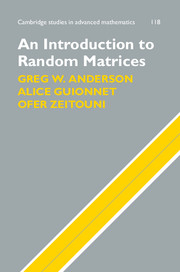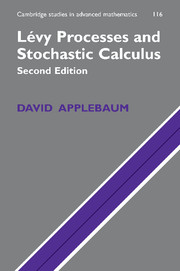Refine search
Actions for selected content:
3023 results in Probability theory and stochastic processes
2 - Background Results in Representation Theory
-
- Book:
- Random Fields on the Sphere
- Published online:
- 07 October 2011
- Print publication:
- 25 August 2011, pp 12-44
-
- Chapter
- Export citation
6 - Characterizations of Isotropy
-
- Book:
- Random Fields on the Sphere
- Published online:
- 07 October 2011
- Print publication:
- 25 August 2011, pp 134-168
-
- Chapter
- Export citation
References
-
- Book:
- Random Fields on the Sphere
- Published online:
- 07 October 2011
- Print publication:
- 25 August 2011, pp 326-337
-
- Chapter
- Export citation
1 - Introduction
-
- Book:
- Random Fields on the Sphere
- Published online:
- 07 October 2011
- Print publication:
- 25 August 2011, pp 1-11
-
- Chapter
- Export citation
4 - Background Results in Probability and Graphical Methods
-
- Book:
- Random Fields on the Sphere
- Published online:
- 07 October 2011
- Print publication:
- 25 August 2011, pp 85-113
-
- Chapter
- Export citation
13 - Appendix
-
- Book:
- Random Fields on the Sphere
- Published online:
- 07 October 2011
- Print publication:
- 25 August 2011, pp 312-325
-
- Chapter
- Export citation
7 - Limit Theorems for Gaussian Subordinated Random Fields
-
- Book:
- Random Fields on the Sphere
- Published online:
- 07 October 2011
- Print publication:
- 25 August 2011, pp 169-193
-
- Chapter
- Export citation
12 - Spin Random Fields
-
- Book:
- Random Fields on the Sphere
- Published online:
- 07 October 2011
- Print publication:
- 25 August 2011, pp 282-311
-
- Chapter
- Export citation
8 - Asymptotics for the Sample Power Spectrum
-
- Book:
- Random Fields on the Sphere
- Published online:
- 07 October 2011
- Print publication:
- 25 August 2011, pp 194-222
-
- Chapter
- Export citation
Index
-
- Book:
- Random Fields on the Sphere
- Published online:
- 07 October 2011
- Print publication:
- 25 August 2011, pp 338-341
-
- Chapter
- Export citation
10 - Spherical Needlets and their Asymptotic Properties
-
- Book:
- Random Fields on the Sphere
- Published online:
- 07 October 2011
- Print publication:
- 25 August 2011, pp 245-264
-
- Chapter
- Export citation
9 - Asymptotics for Sample Bispectra
-
- Book:
- Random Fields on the Sphere
- Published online:
- 07 October 2011
- Print publication:
- 25 August 2011, pp 223-244
-
- Chapter
- Export citation
Contents
-
- Book:
- Random Fields on the Sphere
- Published online:
- 07 October 2011
- Print publication:
- 25 August 2011, pp vii-x
-
- Chapter
- Export citation
Preface
-
- Book:
- Random Fields on the Sphere
- Published online:
- 07 October 2011
- Print publication:
- 25 August 2011, pp xi-xii
-
- Chapter
- Export citation

A User's Guide to Measure Theoretic Probability
-
- Published online:
- 29 March 2011
- Print publication:
- 10 December 2001

An Introduction to Random Matrices
-
- Published online:
- 03 February 2011
- Print publication:
- 19 November 2009

Lévy Processes and Stochastic Calculus
-
- Published online:
- 25 January 2011
- Print publication:
- 30 April 2009
Chapter 6 - Some Extensions and Applications of Martingale Theory
-
- Book:
- Probability Theory
- Published online:
- 05 June 2012
- Print publication:
- 31 December 2010, pp 233-265
-
- Chapter
- Export citation
Chapter 7 - Continuous Parameter Martingales
-
- Book:
- Probability Theory
- Published online:
- 05 June 2012
- Print publication:
- 31 December 2010, pp 266-298
-
- Chapter
- Export citation
Chapter 10 - Wiener Measure and Partial Differential Equations
-
- Book:
- Probability Theory
- Published online:
- 05 June 2012
- Print publication:
- 31 December 2010, pp 400-455
-
- Chapter
- Export citation
